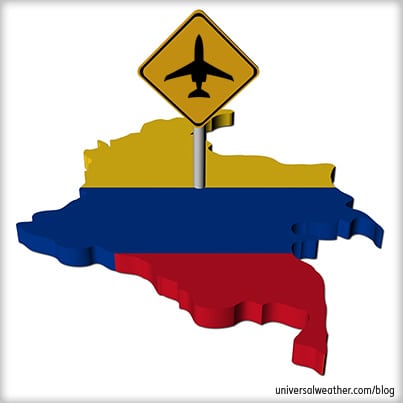Operating to Colombia – Landing Permits, Importation and More


In most cases, business aviation flights to Colombia don’t require landing permits, airport slots or Prior Permissions Required (PPRs) unless the intended stay is longer than 48 hours or operating domestically. For longer stays, there are permit and aircraft importation considerations to bear in mind. Always confirm with your 3rd-party provider what’s required based on the specifics of your mission. Here are some tips to help you plan a mission to Colombia:
1. Corporate traffic to Colombia remains strong
Traffic to Colombia remains steady, regardless of security issues, with the majority of inbound traffic originating from the U.S. The most popular destinations for business aviation operators include Bogota (SKBO), Cartagena (SKCG) and Barranquilla (SKBQ). All three airports operate 24/7. Aircraft parking is generally not an issue in Colombia, and you’ll only require airport slots and PPRs at times of large local events.
2. Know Colombian landing permit requirements
Landing permits are not needed for private non-revenue operations with stays on the ground in Colombia of 48 hours or less. Charter (non-scheduled commercial) operations of aircraft up to and including the size of a Bombardier Global Express also do not require permits for stays of up to 48 hours. Permits are required for all charter aircraft larger than a Bombardier Global with "charter" or "public transportation" on their airworthiness certificates and for any aircraft – private non-revenue or charter – staying in Colombia for more than 48 hours or flying domestic legs within the country.
3. The 48-hour permit-free time limit cannot be extended
If you land in Colombia without a permit, the aircraft must depart prior to the 48-hour mark. A permit can be applied for upon landing, but the confirmation can’t be guaranteed, as it is a short-notice request. Should you wish to stay longer, and the permit is denied, you’ll need to depart the country prior to reaching the 48-hour limit, fly to an international destination and return. Assuming that you’re arriving without a permit, you’ll be allowed another 48 hours on the ground.
4. Be mindful of the permit process
The Colombian Civil Aviation Authority (CAA) issues all permits. Their office hours are 0800-1700 local, Monday-Friday. No permit requests are processed on weekends. In addition to standard documentation, including certificates of registration, airworthiness and worldwide insurance, Colombia requires serial numbers of the aircraft and all engines along with copies of the crew’s pilot licenses and medical certificates to be submitted with the landing permit requests. Permit lead time is 72 hours, but the CAA may, at its discretion, process requests with shorter notice.
5. Temporary importation of the aircraft may be required
Any aircraft staying in Colombia for more than five days must be imported. Importation is done at your first airport of arrival in Colombia. This is a quick process – typically 15 to 60 minutes – which is taken care of at the airport. The importation fee is based on the maximum takeoff weight (MTOW) of the aircraft and length of stay in Colombia. On departing Colombia, exportation is required. This is generally taken care of by your ground handler after the aircraft departs.
6. Security must be considered when operating to Colombia
When planning a trip to Colombia, it’s best to work with your 3rd-party provider in advance to address security risks within the country and at your specific destinations. Security measures should be considered both on and off airport. Some airports will allow you to station an armed guard at your aircraft, so long as guards have appropriate licenses and airport approvals. Local security risks differ depending on the location. Operators who do not fly to Colombia on a regular basis will often arrange aircraft security, secure transportation and personal security for both passengers and crew while in Colombia. If secure transportation is not desired, it’s recommended that all operators utilize pre-paid vetted transportation arranged by the ground handler. It’s best to avoid public transportation, including local taxis.
7. You’ll generally clear Customs, Immigration and Quarantine (CIQ) in the main terminal
Normal CIQ processing time for international arrivals is approximately 15 minutes. Crew and passengers may clear together if desired. Customs and immigration officials escort passengers and crew members to the terminal clearance area. Passports will be examined and fingerprints taken prior to going through customs clearance with luggage. If visas are needed, they should be arranged pre-trip, as visas cannot be processed on arrival. Colombia currently has no vaccination requirements.
8. Tech stops require customs clearance
CIQ clearance isn’t required for tech stops in Colombia. However, if the aircraft drops off passengers, all crew and passengers will have to clear CIQ.
9. Know all operating considerations when flying to Colombia
Even though no official permits or requirements are in place for transport of non-Colombian minors, it’s best to have appropriate documentation on hand if there is no parent onboard. No import permit is required for personal pets accompanied by their owners, and Colombia does not quarantine healthy pets. Your cat or dog must be vaccinated for rabies at least one month (but no more than two months) prior to entering the country. Within 14 days of travel, an accredited vet must complete a Colombian Veterinary Certificate and have the form endorsed by the governing authority of the country of the pet’s domicile. A copy of the rabies certificate should also be included. Hunting firearms may be brought to Colombia with advance arrangement and appropriate documentation submitted. This documentation includes serial numbers, licenses, quantity of ammunition and caliber of weapons. Always coordinate with your 3rd-party provider, in advance, when traveling with guns and/or pets.
Conclusion
Security should be of primary concern when operating to Colombia. With proper pre-planning and due diligence in researching security risks and issues, operations to Colombia and the region are manageable from a security perspective.
Questions?
If you have any questions about this article, contact me at markhudson@univ-wea.com.



